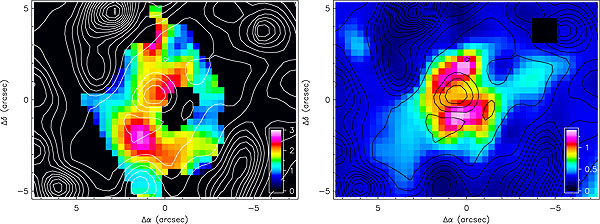Departures from regular rotation, such as winds, elongated orbits or streaming motions, provide very relevant information about the dynamics and history of galaxies. To identify kinematical distortions and to infer how they relate to the gravitational potential,
different techniques such as velocity field fitting or Fourier analysis can be used. However, to obtain reliable results these tools must be used in combination with 2D kinematical data of good spatial resolution. Integral-field spectroscopy (IFS) is an observational
technique especially suited for kinematical studies that can be applied to nearby galaxies, such as M100 (NGC 4321), to obtain velocity maps with detailed spatial information.
The inner region of M100 has been extensively studied at different wavelengths that have revealed some interesting irregular features. On the one hand, the inner region of this galaxy shows a peculiar morphology that is quite different in the optical and in the NIR.
In the optical, the structure is dominated by two spiral arms (broad-band) and an oval-shaped region of enhanced star formation, while the NIR shows an inner bar aligned with the large-scale stellar bar and a pair of small arms emerging from its ends.
Whether there is a single bar or two nested bars that just happen to be aligned has been a greatly debated issue. On the other hand, non-circular motions observed from Halpha data, were interpreted them as the kinematical signatures of gas streaming along the inner part
of the bar, and of density-wave streaming motions across a two-armed minispiral. Relevant pattern speeds of this galaxy have been measured at larger scale by different methods. Recently, data obtained of the inner region of M100 using SAURON on the WHT confirmed that
the star formation ring is formed by young stars, but they also revealed a low gas velocity dispersion compared to its surroundings.
Astronomers using INTEGRAL on the WHT observed the central 2.5 kpc of M100 and obtained data on the stellar and ionized gas velocity fields to analyse the symmetries of the departures from pure rotation and to estimate the nuclear bar pattern speed. Fourier
analysis of the velocity residuals obtained by subtracting an axisymmetric rotation model from the Halpha velocity field indicates that the distortions are global features generated by an m= 2 perturbation of the gravitational potential and can be explained by the nuclear bar.
This bar has been previously observed in the near-infrared but not in the optical continuum dominated by star formation. The detection of the optical counterpart of this bar in the 2D distribution of the old stellar population
and its analysis using the Tremaine–Weinberg method, allowed the determination of the pattern speed of the inner bar, obtaining a value of Ωb= 160 ± 70 km s-1 kpc-1 . This value is considerably larger than the one
obtained when a simple bar model is considered.
Galactic winds are one of the main mechanisms by which galaxies expel metals, dust, cosmic rays, magnetic fields, etc, to the intergalactic medium. This feedback makes winds an important phenomenon in our global understanding of galaxies.
These winds are usually associated with galaxies with strong nuclear activity or with starbursts, which are powerful enough to feed the winds.
However, very little is known of this phenomenon in quiescent, inactive galaxies. M100 is a nearby galaxy with low nuclear activity and a moderate star formation rate of a few solar masses per year. Despite this apparent quiescence, astronomers using INTEGRAL on the WHT found an unexpected fast wind emanating from its nuclear region.
They used a new approach based on integral field spectroscopy which allows both the detection of absorbing material throughout the field of view and the production of a map of the distribution
and kinematics of the absorbers. In addition, they could discriminate kinematically the ionized component of the outflowing material and to produce maps for the distribution and
kinematics of this hotter phase of the wind. This approach provides
a unique simultaneous global view of these two phases of a galactic
wind.
 |
[NII]/Hα line ration for the wind (left) and Galactic (right) components. Contours show intensity of galactic Hα emission. (Extracted from Jiménez-Vicente et al., 2007,
MNRAS, 382, L16) [ JPEG | TIFF ].
|
The primary evidence of the wind is the presence of blueshifted interstellar NaD absorption lines. The velocity field of the absorbers show a clear rotation pattern but which is globally blueshifted (~ -115 km s-1) with respect to the systemic velocity of the galaxy.
The emission lines also present a blueward component arising from the ionized gas phase of the galactic wind. The velocity field of the ionized gas wind component shows no evidence of rotation but exhibits a pattern that can be interpreted in terms of the projection of an outflowing cone or shell.
The wind component has [N II]/Halpha ratios of about 1.8, typical of shock ionization.
The ionized component of the wind can be identified with an expanding shell of shocked gas, and the neutral component with disc gas entrained in the wind at the interface of the expanding shell with the galactic interstellar medium. The galactic wind seems to be driven uniquely by the
nuclear starburst. The analysis indicates that a non-negligible fraction of the wind material might escape to the intergalactic medium (IGM). In this case, if the wind detected in M100 were representative of similar phenomena in other galaxies with low to moderate activity, the current estimates of
metal and dust content of the IGM might be drastically underestimated.
References:
- J. Jiménez-Vicente et al., 2007, "Discovery of a galactic wind in the central region of M100", MNRAS, 382, L16.
- A. Castillo-Morales et al., 2007, "Non-circular motion evidence in the circumnuclear region of M100 (NGC 4321)", MNRAS, 380, 489.
- IAC Annual Report 2007.

